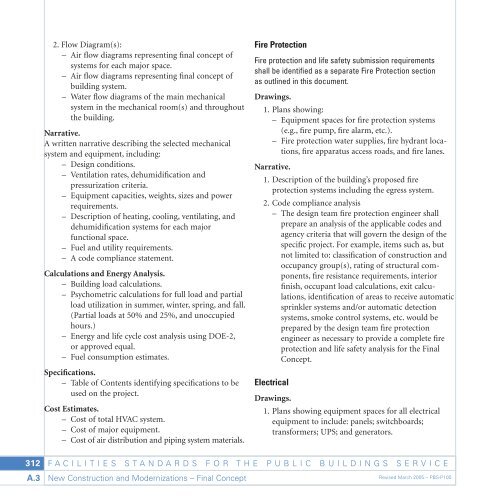Appendix - GSA
Appendix - GSA
Appendix - GSA
You also want an ePaper? Increase the reach of your titles
YUMPU automatically turns print PDFs into web optimized ePapers that Google loves.
2. Flow Diagram(s):<br />
– Air flow diagrams representing final concept of<br />
systems for each major space.<br />
– Air flow diagrams representing final concept of<br />
building system.<br />
– Water flow diagrams of the main mechanical<br />
system in the mechanical room(s) and throughout<br />
the building.<br />
Narrative.<br />
A written narrative describing the selected mechanical<br />
system and equipment, including:<br />
– Design conditions.<br />
– Ventilation rates, dehumidification and<br />
pressurization criteria.<br />
– Equipment capacities, weights, sizes and power<br />
requirements.<br />
– Description of heating, cooling, ventilating, and<br />
dehumidification systems for each major<br />
functional space.<br />
– Fuel and utility requirements.<br />
– A code compliance statement.<br />
Calculations and Energy Analysis.<br />
– Building load calculations.<br />
– Psychometric calculations for full load and partial<br />
load utilization in summer, winter, spring, and fall.<br />
(Partial loads at 50% and 25%, and unoccupied<br />
hours.)<br />
– Energy and life cycle cost analysis using DOE-2,<br />
or approved equal.<br />
– Fuel consumption estimates.<br />
Specifications.<br />
– Table of Contents identifying specifications to be<br />
used on the project.<br />
Cost Estimates.<br />
– Cost of total HVAC system.<br />
– Cost of major equipment.<br />
– Cost of air distribution and piping system materials.<br />
Fire Protection<br />
Fire protection and life safety submission requirements<br />
shall be identified as a separate Fire Protection section<br />
as outlined in this document.<br />
Drawings.<br />
1. Plans showing:<br />
– Equipment spaces for fire protection systems<br />
(e.g., fire pump, fire alarm, etc.).<br />
– Fire protection water supplies, fire hydrant locations,<br />
fire apparatus access roads, and fire lanes.<br />
Narrative.<br />
1. Description of the building’s proposed fire<br />
protection systems including the egress system.<br />
2. Code compliance analysis<br />
– The design team fire protection engineer shall<br />
prepare an analysis of the applicable codes and<br />
agency criteria that will govern the design of the<br />
specific project. For example, items such as, but<br />
not limited to: classification of construction and<br />
occupancy group(s), rating of structural components,<br />
fire resistance requirements, interior<br />
finish, occupant load calculations, exit calculations,<br />
identification of areas to receive automatic<br />
sprinkler systems and/or automatic detection<br />
systems, smoke control systems, etc. would be<br />
prepared by the design team fire protection<br />
engineer as necessary to provide a complete fire<br />
protection and life safety analysis for the Final<br />
Concept.<br />
Electrical<br />
Drawings.<br />
1. Plans showing equipment spaces for all electrical<br />
equipment to include: panels; switchboards;<br />
transformers; UPS; and generators.<br />
312<br />
A.3<br />
F A CILI TIES S T AND ARDS FOR THE PUBLIC BUILDINGS SER VICE<br />
New Construction and Modernizations – Final Concept<br />
Revised March 2005 – PBS-P100
















